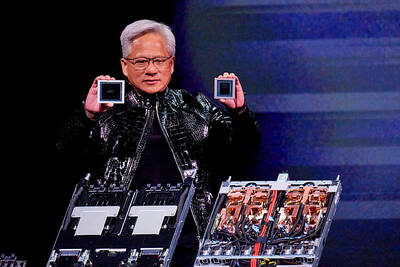Taiwan's key stock index had its biggest gain in seven months after a second opposition politician headed for China, the nation's biggest trading partner, in an attempt to mend ties.
Hon Hai Precision Industry Co (
The bottom for relations between China and Taiwan "may have passed and the ground has been laid for improved communication," Dickson Ho (何資文), head of research at Morgan Stanley in Taipei, wrote in a note dated yesterday. "We expect the market to react favorably to any positive developments on the political front."
The TAIEX jumped 123.82, or 2.1 percent, to 5,927.50, its biggest gain since Oct. 4.
More than five stocks advanced for every one that declined.
Futures due this month added 1.7 percent to 5,902.
Hon Hai Precision, the nation's largest electronics company by sales and which counts China as a manufacturing base, rose 2.5 percent to NT$144.50. Quanta Computer Inc (
EVA Airways, the nation's second-biggest airline, added 1.3 percent to NT$15.20. China Airlines (
"Tensions will soon be a thing of the past," said Phil Chen, who helps manage the equivalent of US$1.9 billion at Grand Cathay Securities Investment Trust Co (
Morgan Stanley Capital International Inc announced last June it will raise the weighting of Taiwan's stocks in global indexes to 100 percent from 75 percent on May 31. Investors may buy about US$4 billion of the nation's equities to track the benchmarks, analysts and investors said at the time.
"The timing is perfect for Taiwan stocks. We are seeing investors in Asian markets shifting investment to the island ahead of the MSCI index rebalance this month," said Jerry Chen, a fund manager at Taipei-based First Global Investment Trust Co (元大投信).
Overseas institutional investors bought a net NT$10.64 billion worth of shares on Thursday.

Nvidia Corp chief executive officer Jensen Huang (黃仁勳) on Monday introduced the company’s latest supercomputer platform, featuring six new chips made by Taiwan Semiconductor Manufacturing Co (TSMC, 台積電), saying that it is now “in full production.” “If Vera Rubin is going to be in time for this year, it must be in production by now, and so, today I can tell you that Vera Rubin is in full production,” Huang said during his keynote speech at CES in Las Vegas. The rollout of six concurrent chips for Vera Rubin — the company’s next-generation artificial intelligence (AI) computing platform — marks a strategic

Enhanced tax credits that have helped reduce the cost of health insurance for the vast majority of US Affordable Care Act enrollees expired on Jan.1, cementing higher health costs for millions of Americans at the start of the new year. Democrats forced a 43-day US government shutdown over the issue. Moderate Republicans called for a solution to save their political aspirations this year. US President Donald Trump floated a way out, only to back off after conservative backlash. In the end, no one’s efforts were enough to save the subsidies before their expiration date. A US House of Representatives vote

REVENUE PERFORMANCE: Cloud and network products, and electronic components saw strong increases, while smart consumer electronics and computing products fell Hon Hai Precision Industry Co (鴻海精密) yesterday posted 26.51 percent quarterly growth in revenue for last quarter to NT$2.6 trillion (US$82.44 billion), the strongest on record for the period and above expectations, but the company forecast a slight revenue dip this quarter due to seasonal factors. On an annual basis, revenue last quarter grew 22.07 percent, the company said. Analysts on average estimated about NT$2.4 trillion increase. Hon Hai, which assembles servers for Nvidia Corp and iPhones for Apple Inc, is expanding its capacity in the US, adding artificial intelligence (AI) server production in Wisconsin and Texas, where it operates established campuses. This

US President Donald Trump on Friday blocked US photonics firm HieFo Corp’s US$3 million acquisition of assets in New Jersey-based aerospace and defense specialist Emcore Corp, citing national security and China-related concerns. In an order released by the White House, Trump said HieFo was “controlled by a citizen of the People’s Republic of China” and that its 2024 acquisition of Emcore’s businesses led the US president to believe that it might “take action that threatens to impair the national security of the United States.” The order did not name the person or detail Trump’s concerns. “The Transaction is hereby prohibited,”